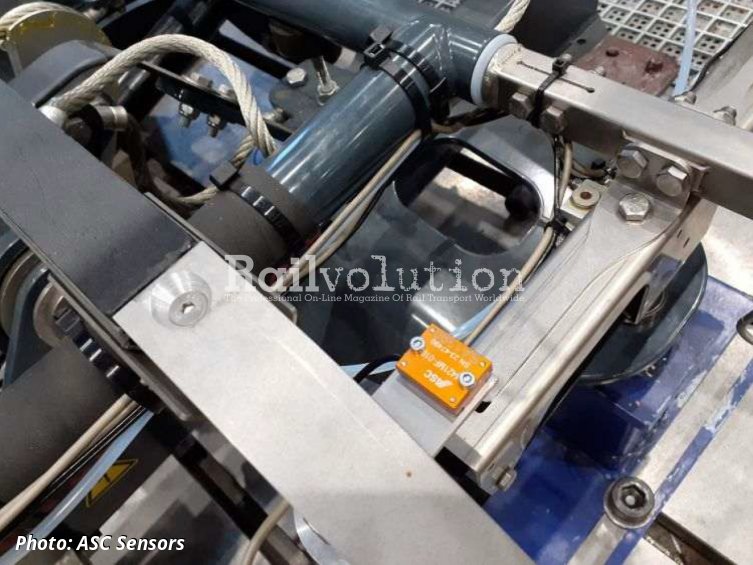ASC Sensors and CETEST elevate testing standards
posted on 21st Apr 2025 12:49
ASC’s inertial sensor solutions help Spanish test and analysis center CETEST to address critical measuring and evaluation challenges, to provide unrivalled monitoring outcomes to customers across the world.
CETEST is an independent technology testing and analysis specialist based in northern Spain, providing advanced engineering, testing and monitoring services. It is accredited according to ISO17025, the principal universal standard ensuring competent quality testing, monitoring and calibration results by laboratories and technology companies worldwide.
Based on a more than 30-year legacy in railway technology evaluation CETEST has been helping leading global rail manufacturers including Alstom, CAF, Hitachi, Siemens or Stadler through the relevant regulatory approval processes for new and refurbished vehicles, individual components and systems around the world. In 2010, following EN9100 accreditation, CETEST expanded its services to the aeronautics and wind power sectors.
Pantograph optimization at more than 350 km/h
One area in which the Spanish testing lab has developed industry leading expertise is the critical interaction between pantographs and overhead lines. This aspect is key in the validation of new rolling stock to run on existing infrastructure, as well as in approving new infrastructure designs. It also bears a significant impact on maintenance costs.
Uniaxial ASC 4421MF accelerometers play a pivotal role at CETEST in evaluating pantograph performance as well as rolling stock ride comfort and dynamic behavior. Based on proven MEMS technology and capacitive operating principle, they feature a broad measurement range of 2 to 200 g. The integrated electronic circuitry enables a differential analog voltage output (±2.7 V FSO) and flexible power supply voltage from 5 to 40 VDC. ASC’s medium-frequency (MF) accelerometers provide a wide frequency response range of 0 Hz to 7 kHz (±3 dB) and an extremely robust design with shock resistance up to 6,000 g.
“Amongst other applications, we’re using ASC’s accelerometers in a special precision instrumentation system for pantograph contact force testing at train speeds exceeding 350 km/h,” says Carlos Carmuega Tena, Quality Director at CETEST, who has been leading this development. To that end, the ASC MF4421 is employed to measure the vertical acceleration in the pantograph. Based on these measurements, the inertia forces due to effects of the mass of components between the sensors and the contact point get corrected.
Robust sensors resist NVH and electromagnetic interference
In these pantograph test series, the sensors are installed between the pantograph body and the contact strip. The latter is in direct contact with the catenary and represents, therefore, a high voltage area. “Not only does this position lead to high heat exposure to due to the voltages used,” the expert explains. “They also cause plenty of electromagnetic interferences. And the extreme exposure of this demanding sensor application to noise, vibrations and harsh environmental conditions (NVH) like heat, rain and ice plays an even bigger role in obtaining accurate, stable results.”
To resist all of that, the uniaxial ASC 4421MF series features a reliable lightweight aluminum housing of protection class IP67 and an integrated cable of configurable length with connectors. Its ultra-flat design allows for convenient, easy installation, a fundamental requirement in pantograph testing as the position, size and weight of the sensors used are of particular relevance for the validity of the tests results: standard EN50317 establishes limits to the aerodynamic influence, which the measurement system must comply with.
“When we evaluated accelerometers from other manufacturers previously, an issue we encountered was that those were easily damaged by the high voltages,” Carmuega Tena remembers. “Using ASC’s robust sensors, we can now avoid electrical problems due to voltage and obtain good quality signals, despite electromagnetic interferences and other external conditions.”
Ride comfort & dynamic behavior testing
“While our original collaboration with ASC Sensors started because of their accelerometers’ superior measuring behaviors and electromagnetic immunity benefits in our pantograph tests, we soon started exploring additional uses,” reflects the CETEST engineer. “Another decisive advantage was the convenient compatibility of ASC’s sensor technology with our existing instrumentation and measurement data processing ecosystem. Its competitive pricing, delivery times, compact dimensions and ease of installation also turned out to be a great fit.”
Therefore, after rigorous evaluations of various alternative sensor models, CETEST started leveraging the ASC 4421MF accelerometer in dynamic behavior and ride comfort analyses, too. For passenger comfort testing according to ISO2631 and EN12299, the sensors are installed inside the respective vehicle to measure all vertical, lateral and longitudinal movements, obtaining comfort values in each position.
For dynamic behavior tests under EN14363, inertial sensors get installed at various points inside the train as well as bogies and axle boxes externally. “The ASC accelerometers’ broad available measurement range lends itself to this approach,” states Carmuega Tena. With vibration loads and frequencies varying significantly between the different areas and components, CETEST utilizes accelerometers ranging from 2 to 100 g. “Apart from their individual ranges, all other parameters of the ASC 4421MF series remain consistent. Which greatly facilitates both their integration in our measurement system and achieving consistent, valid results.“



